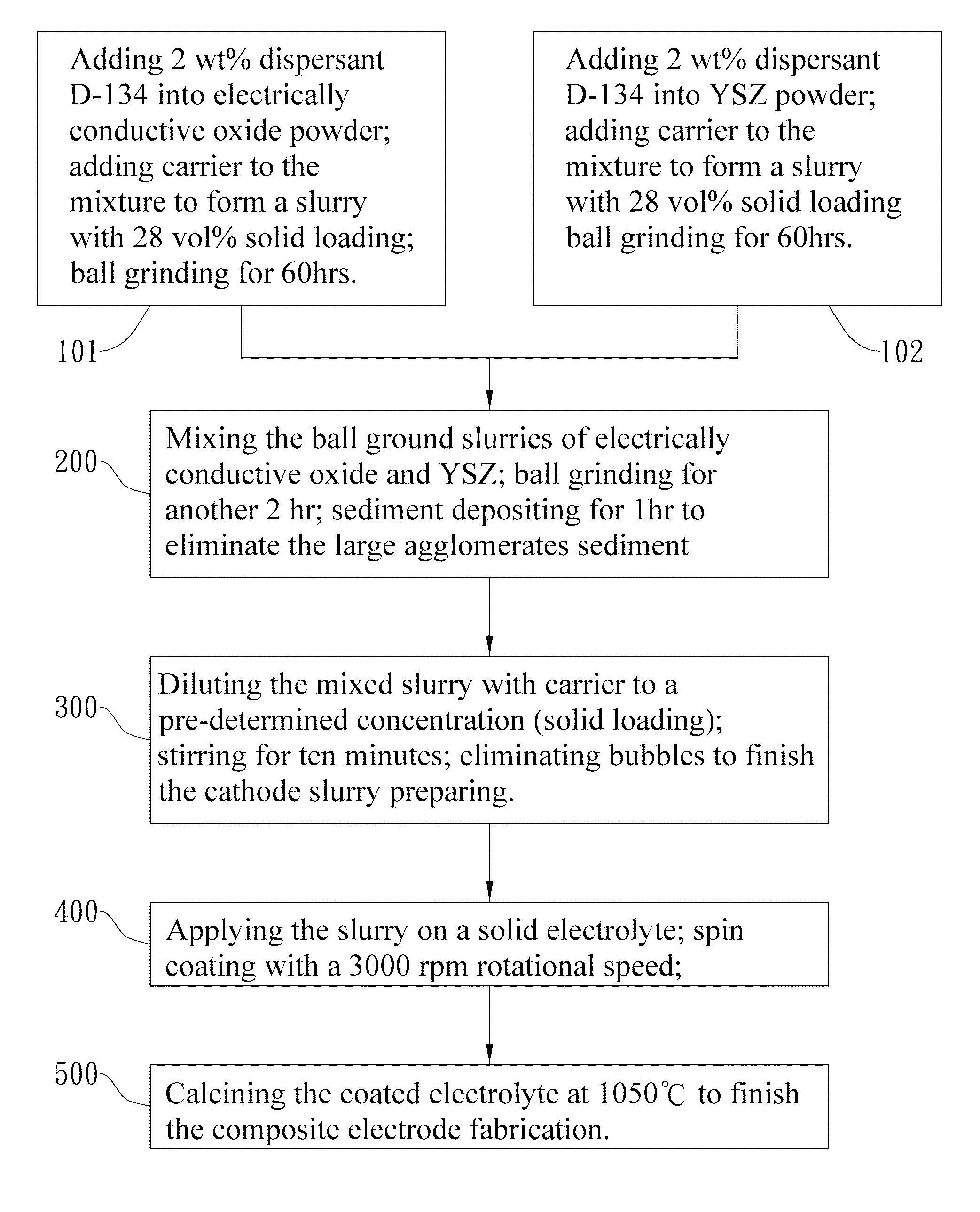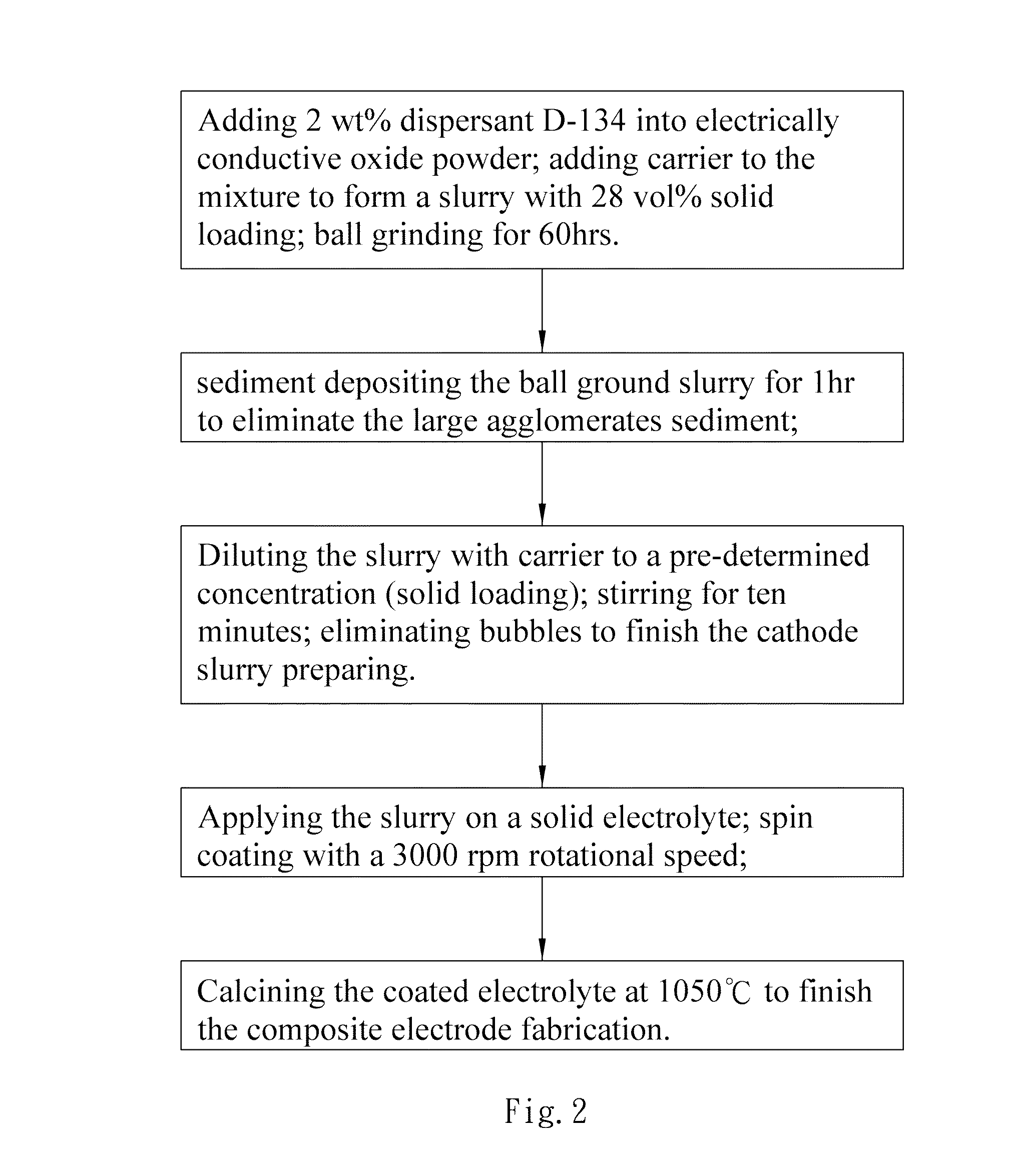Porous oxide electrode layer and method for manufacturing the same
a technology of porous oxide and electrode layer, which is applied in the direction of electrochemical generators, cell components, coatings, etc., can solve the problems of easy cracks, high cost, and more time-consuming methods, and achieves low cost, low cost, and uniform thickness.
- Summary
- Abstract
- Description
- Claims
- Application Information
AI Technical Summary
Benefits of technology
Problems solved by technology
Method used
Image
Examples
embodiment 1
[0029]In table 1, simple electrode material means LSM or LSCF, and composite electrode material means LSM with YSZ added or LSCF with YSZ added; in the composite electrode slurry samples (i.e. samples 1˜11), the weight ratios of LSM:YSZ and the weight ratios of LSCF:YSZ are all 1:1. The LSCF material used in these embodiments is La0.6Sr0.4Co0.2Fe0.8O3 (abbreviated as LSCF). The solid loading in table 1 means the weight percentage of the solids in the prepared slurry, which is ready for the spin coating step. The carrier in table 1 is water, polyethylene glycol with an average molecular weight around 200 (PEG200), or the mixture of the two, wherein the weight ratios of water:PEG200 in the carriers are given in table 1. The PVA concentrations given in table 1 are the weight % based on the powder mass in the prepared slurry, wherein PVA is added as binder. The method for preparing the slurry samples in this invention is demonstrated by the preparing of the water-based (water as the car...
first embodiment
[0032]this invention is to explore the relationship between the solid loading of the slurry and the thickness of the fabricated electrode. The water-based composite electrode slurry with a 15 wt % solid loading (table 1, sample 1, deionized water as the carrier) is spin-coated on a thin solid electrolyte layer for 5 seconds with a rotational speed of 3000 rpm. The coated electrolyte is calcined at 1050° C. for one hour to form the composite electrode film on the solid electrolyte. The thickness of this made composite electrode is only about 800 nm; the reasons for this thickness are as follows: the viscosity of the water-based composite electrode is too low, and the slurry is spin-coated on a fine solid electrolyte layer; therefore, most of the deposited slurry is thrown away from the surface of the electrolyte.
[0033]The composite electrode slurry with a 30 wt % solid loading (table 1, sample 2) is used for manufacturing the electrode with the same process, and the thickness of the ...
second embodiment
[0034]this invention explores the effect of adding binder to the electrode slurry to increase the viscosity of the slurry; in this embodiment, PVA is used as the binder. Slurry sample 4 in table 1 is water-based LSM+YSZ composite electrode slurry; the solid loading of this slurry is 50 wt %, and the PVA concentration is 5 wt %. The experimental result shows the additional PVA helps to increase the thickness of the fabricated composite electrode; however, the uniformity deteriorates as shown by FIG. 4, wherein FIG. 4(a) and FIG. 4(b) are scanning electron microscope (SEM) images of the surface of the electrode made from slurry sample 4 with different magnifications, and FIG. 4(c) is the cross-sectional SEM image of the electrode. The agglomerations shown in FIG. 4(a) and FIG. 4(b) may be the result of the incompletely dissolved PVA. This embodiment also explores the effect of the additional PVA to the LSCF+YSZ composite electrode; the slurry samples used are samples 5, 6 and 7 in tab...
PUM
| Property | Measurement | Unit |
|---|---|---|
| porosity | aaaaa | aaaaa |
| thickness | aaaaa | aaaaa |
| porosity | aaaaa | aaaaa |
Abstract
Description
Claims
Application Information
 Login to View More
Login to View More - R&D
- Intellectual Property
- Life Sciences
- Materials
- Tech Scout
- Unparalleled Data Quality
- Higher Quality Content
- 60% Fewer Hallucinations
Browse by: Latest US Patents, China's latest patents, Technical Efficacy Thesaurus, Application Domain, Technology Topic, Popular Technical Reports.
© 2025 PatSnap. All rights reserved.Legal|Privacy policy|Modern Slavery Act Transparency Statement|Sitemap|About US| Contact US: help@patsnap.com



